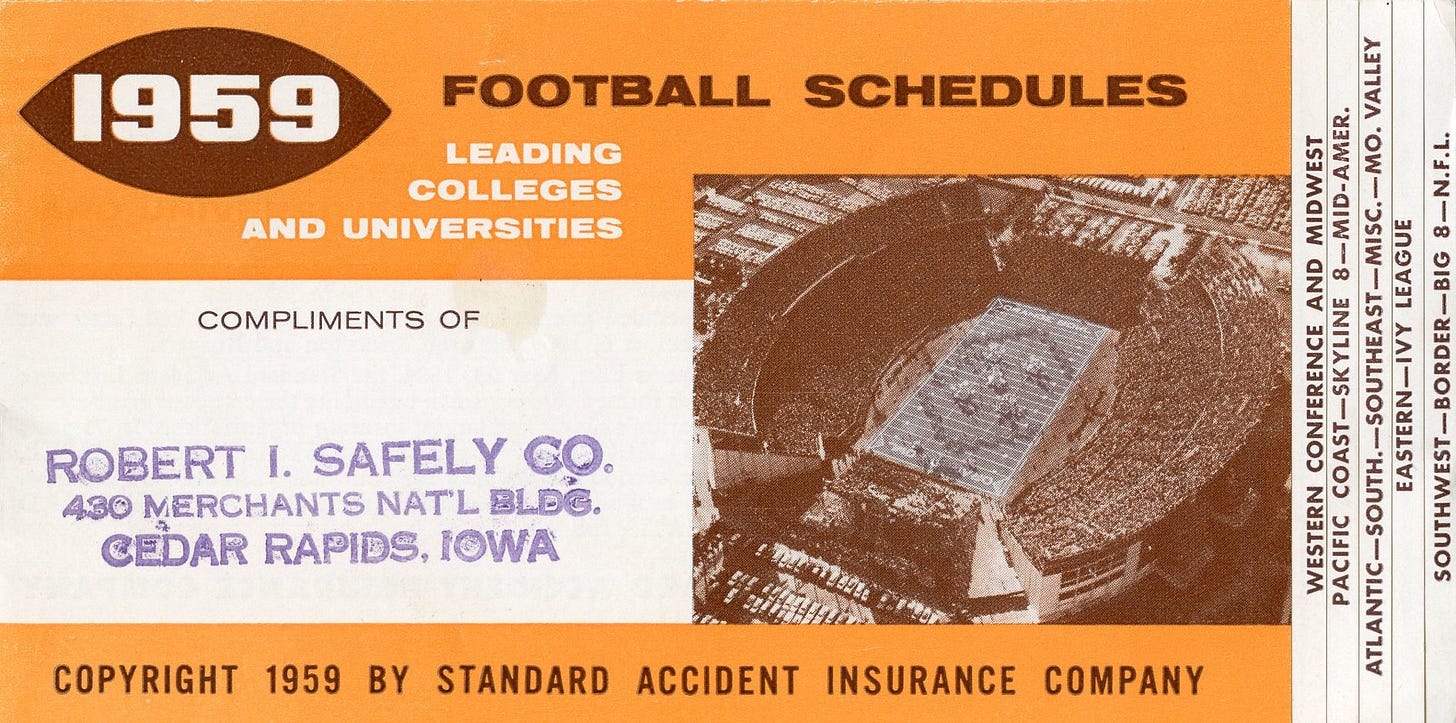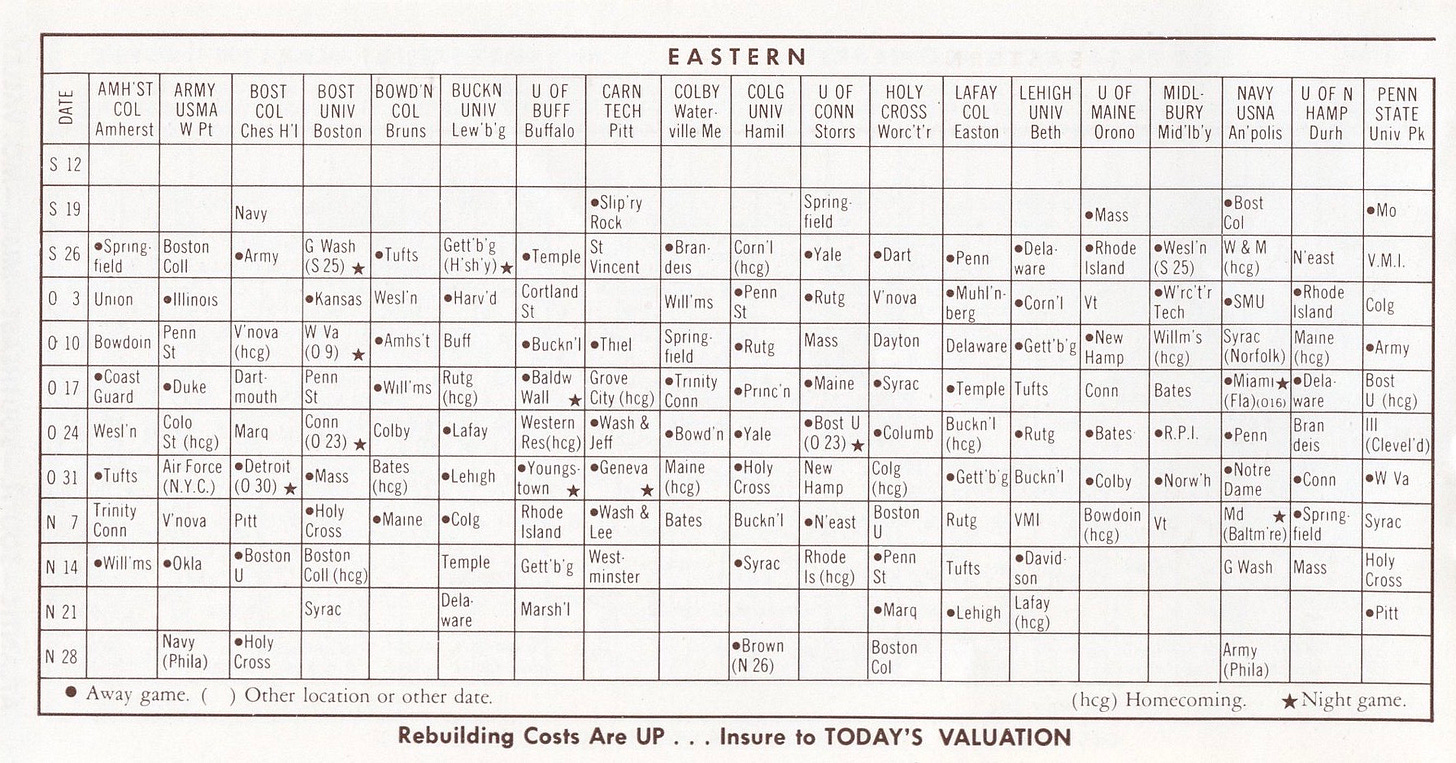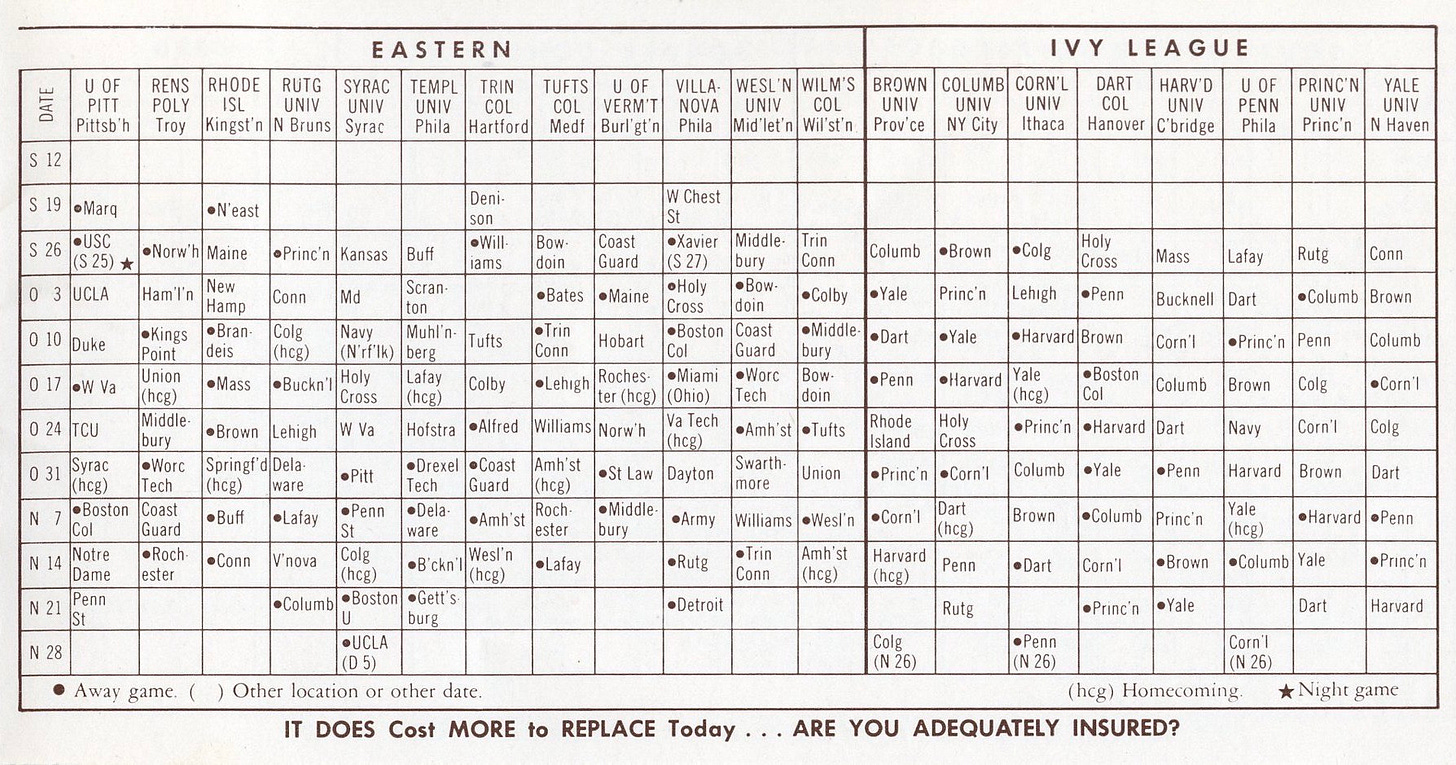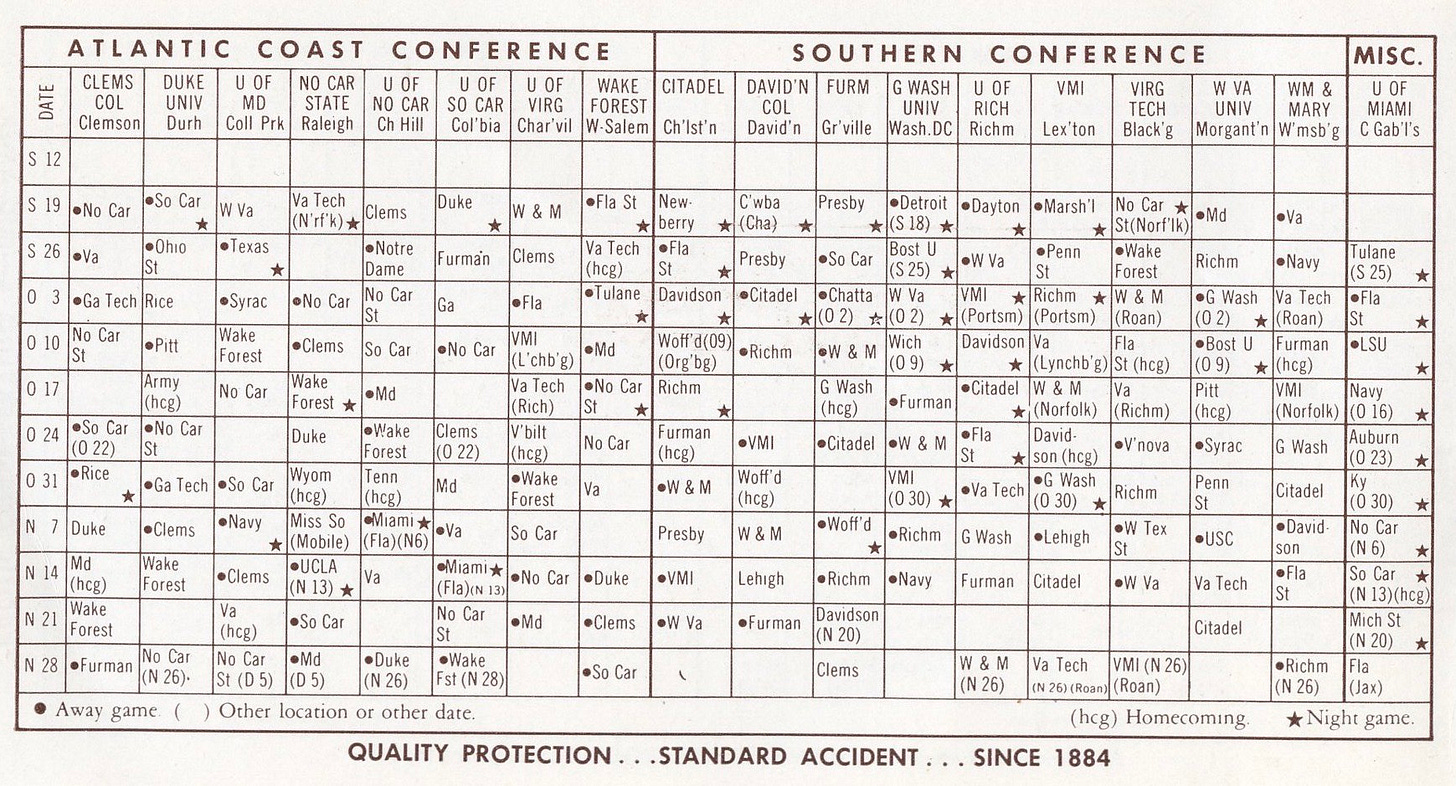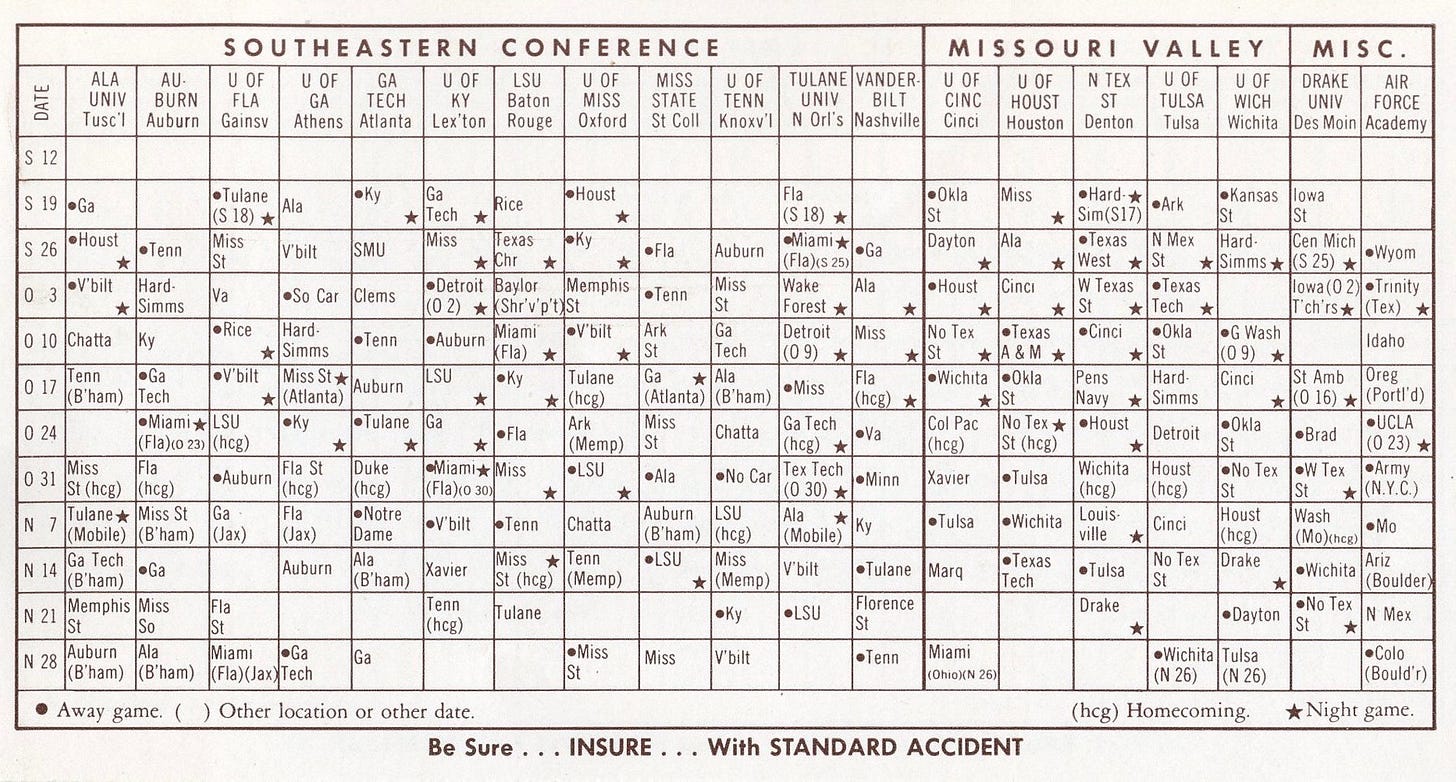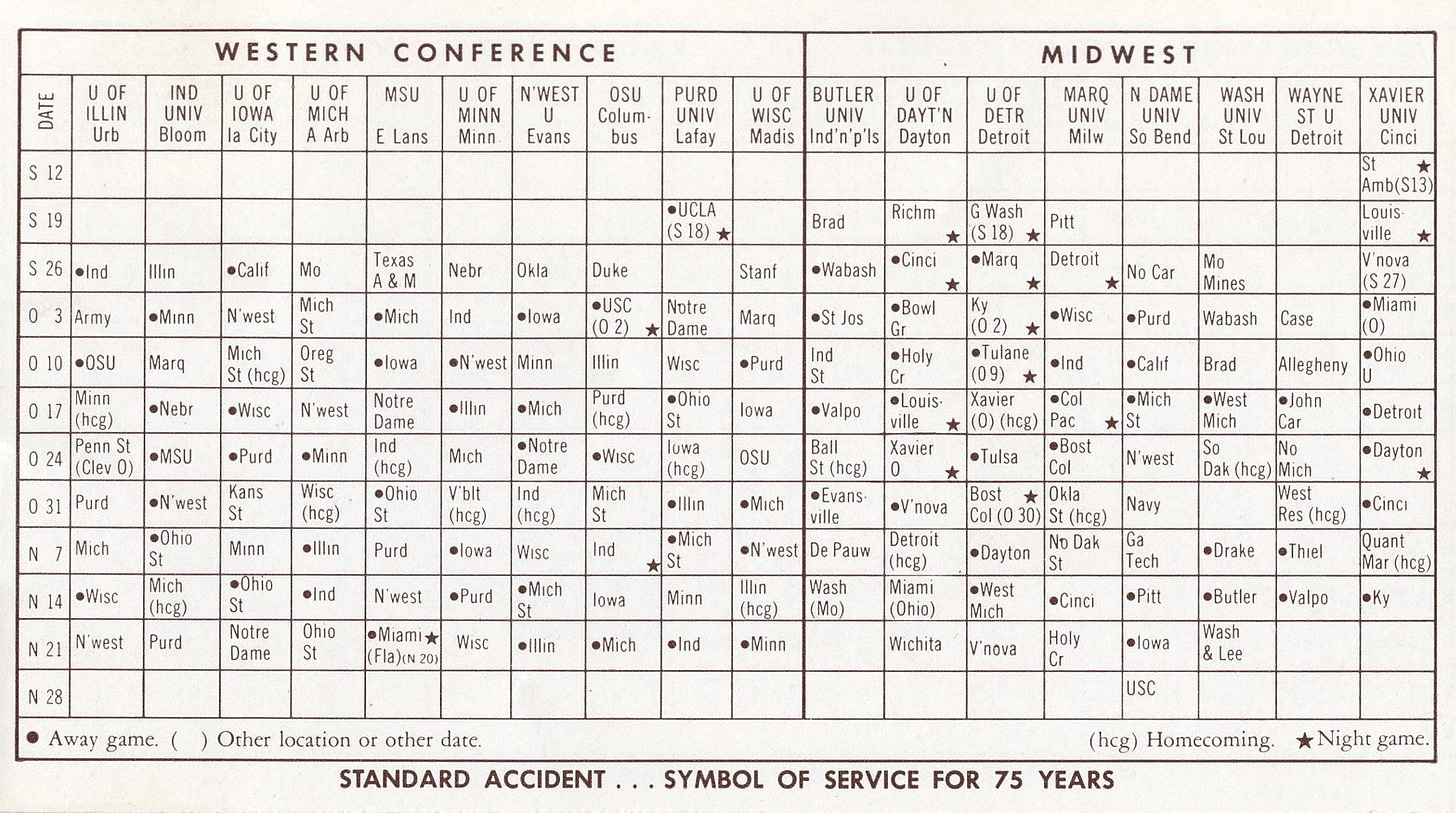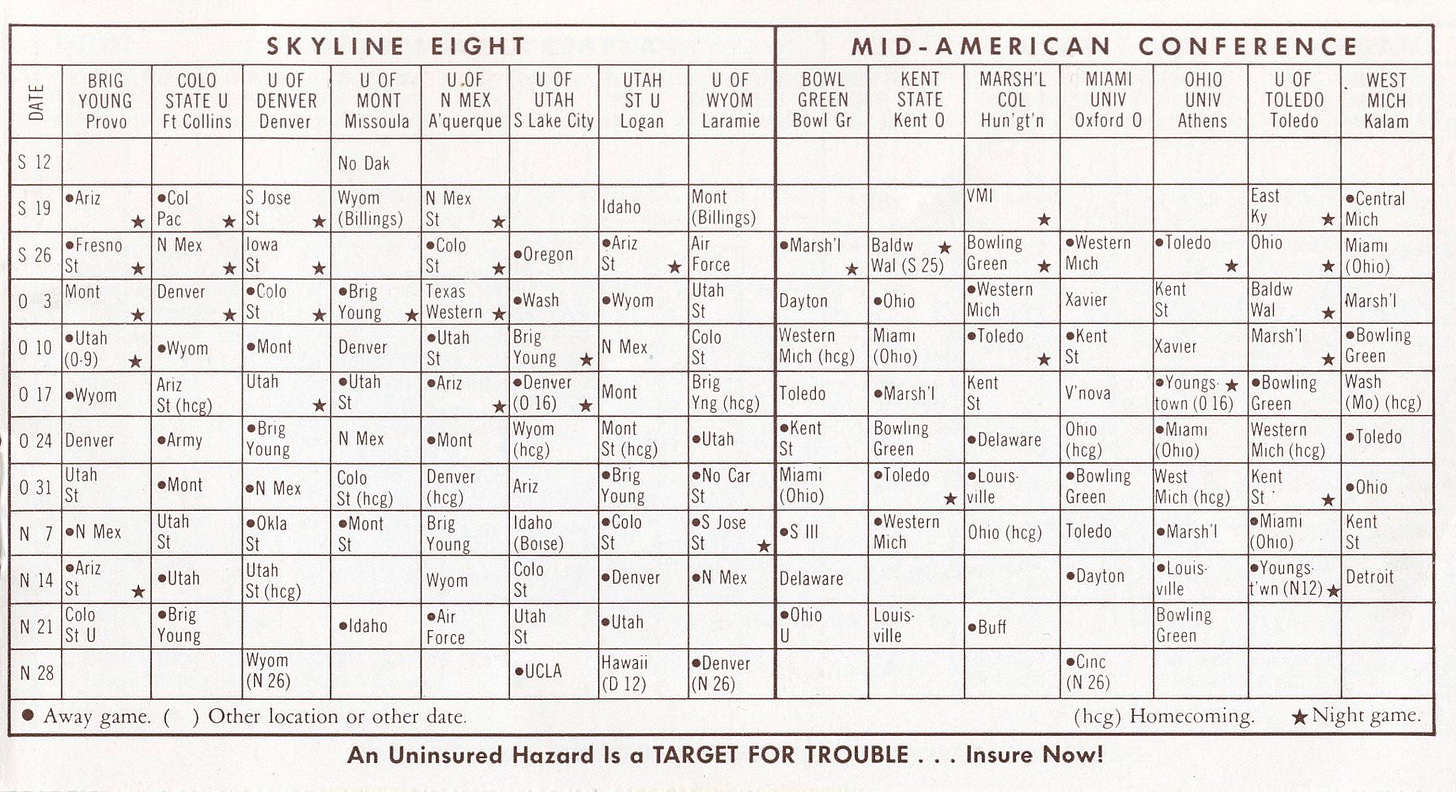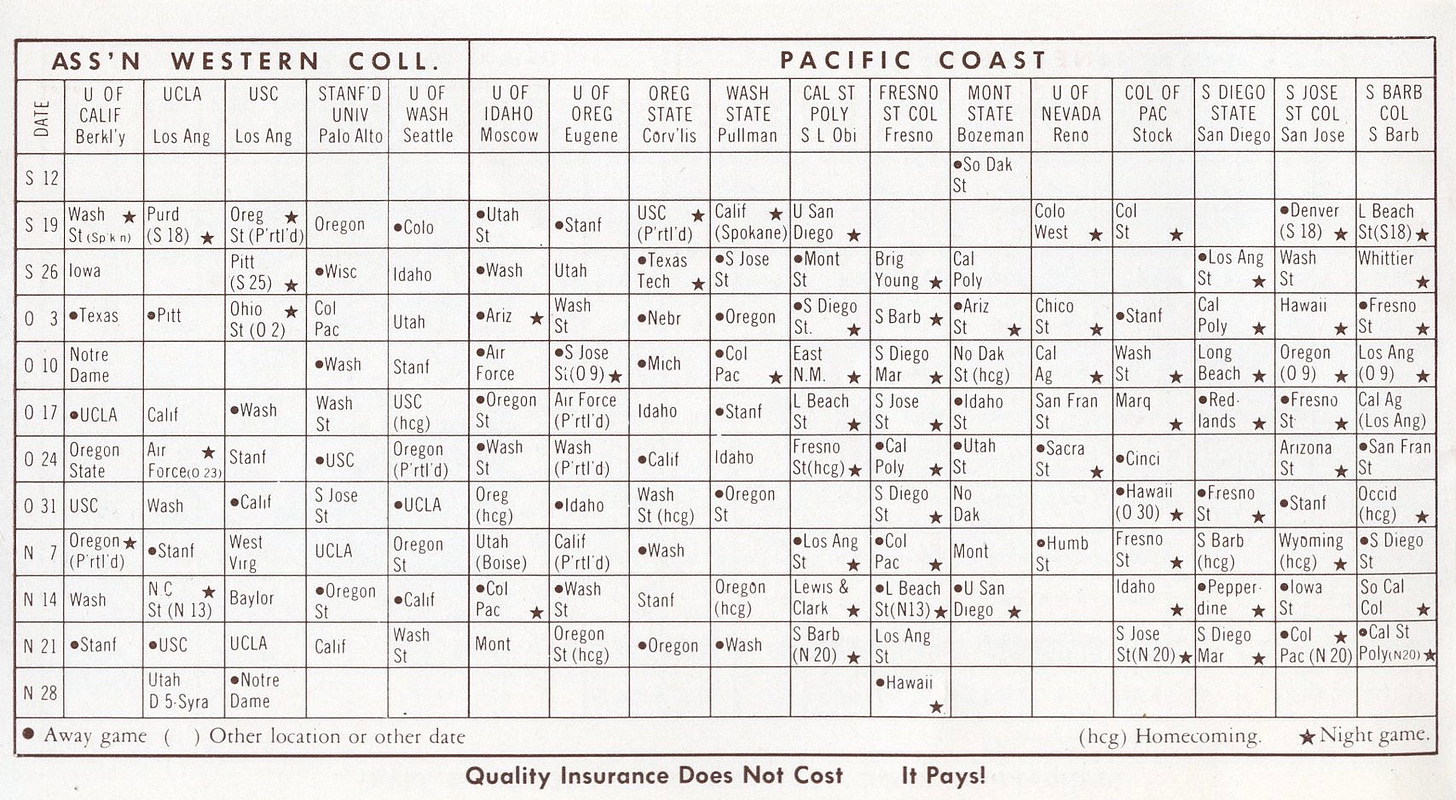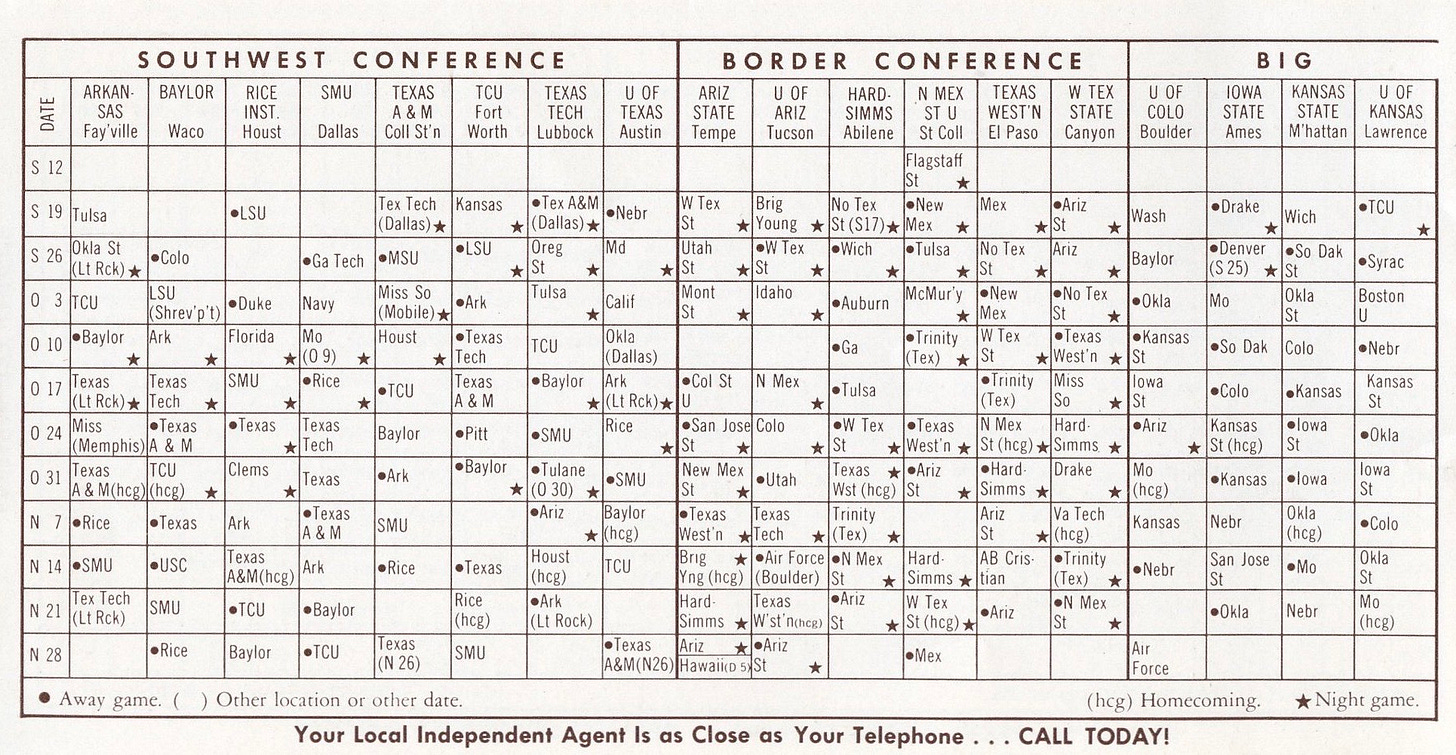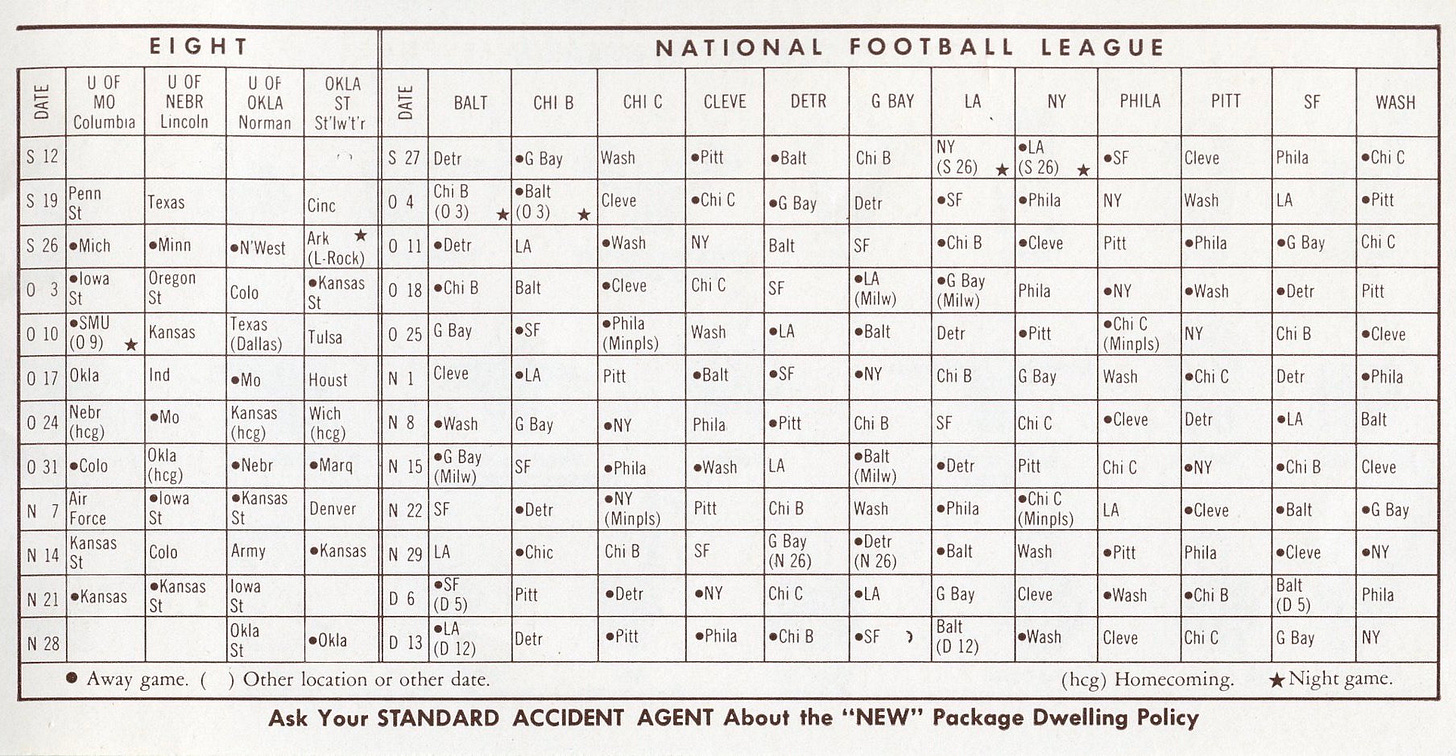60+ Years of College Football Conference Realignment
With the opening of the college season several days away, this article looks at college football conference realignment since 1959. (A recent article looked at changes in the college football landscape changed since 1940 as related to the NCAA adopting its divisional structure.) We’ll also take a quick look at the 1959 NFL (one year before the AFL arrived on the scene) versus today.
As with the previous article, a promotional booklet listing the schedules for conferences nationwide will facilitate our tour. The booklet, published by the Standard Accident Insurance Company, includes the schedules of twelve conferences and major independents (by region). Several conferences no longer exist, and most others are dramatically different.
Eastern Independents and the Ivy League
While there were many Eastern Independents in 1959, they have since scattered to the wind. Army and UConn are the only current Independents, and both joined and then dropped out of leagues since then. The ACC picked up three teams and the Big Ten two. Three others play in Group of 5 conferences, nine teams play FCS in the Colonial and Patriot, ten play DIII, and two have dropped football.
ACC (3): Boston College, Pitt, Syracuse
B1G (2): Penn State, Rutgers
American (2): Navy, Temple
Mid-American (1): Buffalo
FBS Independent (2): Army, UConn,
FCS Colonial (4): Maine, UNH, Rhode Island, Villanova
FCA Patriot (5): Bucknell, Colgate, Holy Cross, Lafayette, Lehigh
DIII (10): Amherst, Bowdoin, Carnegie Tech, Colby, Middlebury, RPI, Trinity, Tufts, Wesleyan, Williams
Dropped (2): Boston U., Vermont
The Ivy League is the only conference whose membership has been unchanged since 1959. Of course, they shifted to DI-AA (now FCS) in 1982.
Ivy (8): Brown, Columbia, Cornell, Dartmouth, Harvard, Penn, Princeton, Yale
Atlantic Coast and Southern
Six of the eight ACC teams remain in the conference today; South Carolina became an independent in 1970 before joining the SEC in 1992. Meanwhile, Maryland opted for the Big Ten, and Miami, listed as Miscellaneous, is now in the ACC.
ACC: Clemson, Duke, UNC, NC State, Virginia, Wake Forest
SEC: South Carolina
B1G: Maryland
There have been many variations of the Southern Conference. Only three teams from the 1959 version are still in the SoCon. The conference gave up Virginia Tech to the ACC and West Virginia, improbably, to the Big 12. Everyone else shifted to FCS or dropped football.
ACC (1): Virginia Tech
Big 12 (2): West Virginia
FCS Southern (3): Citadel, Furman, VMI
FCS Colonial (3): Richmond, William & Mary
FCS Pioneer (3): Davidson
Dropped (1): George Washington
Southeastern, Missouri Valley, and Miscellaneous
Ten of the twelve SEC members in 1959 remain in the conference today. Besides the Ivies and the Big Ten, the SEC has been the most stable in retaining its members. Georgia Tech is now in the ACC, and Tulane is in the American.
SEC (10): Alabama, Auburn, Florida, Georgia, Kentucky, LSU, Mississippi, Mississippi State, Tennessee, Vanderbilt
ACC (1): Georgia Tech
American (1): Tulane
Including versions of the conference dating back to the early 1900s, the Missouri Valley likely saw more membership changes than any major conference. Only Cincinnati resides in a Power 5 conference today, three members belong to Group of 5 conferences, and Wichita dropped football. Among the Miscellaneous, Air Force is a Group of 5 team, and Drake is a non-scholarship FCS team.
Big 12 (1): Cincinnati
American (2): Houston, Tulsa
Conference USA (1): North Texas
Dropped (1): Wichita
Mountain West (1): Air Force
FCS Pioneer (1): Drake
Western (Big Ten) and Midwest Independents
All members of the Big Ten in 1959 remain in the conference today. They have since welcomed others to the club, but Chicago is the only school to leave the Western / Big Ten and not return. (Michigan and Iowa left the Big Ten and came back some years back.)
Big Ten (10): Illinois, Indiana, Iowa, Michigan, Michigan State, Minnesota, Northwestern, Ohio State, Purdue, Wisconsin
Among the 1959 Midwest Independents, only Notre Dame can stake that claim today. Butler and Dayton moved to non-scholarship FCS, while Wayne State plays DII and WashU plays WIII. Detroit, Marquette, and Xavier dropped football.
FBS Independent (1): Notre Dame
FCS Pioneer (2): Butler and Dayton
DII (1): Wayne State
DII (1): WashU
Dropped (3): Detroit, Marquette, Xavier
Skyline Eight and Mid-American
Half the Skyline Eight now calls the Mountain West home. Utah eventually skipped off to the Pac-12, and BYU is independent. Montana became a founding member of the FCS Big Sky in 1963, while Denver dropped football after the 1960 season.
Mountain West (4): Colorado State, New Mexico, Utah State, Wyoming
Pac-12 (1): Utah
Independent (1): BYU
FCS Big Sky (1): Montana
Dropped: Denver
Six of the seven Mid-American teams from 1959 remain in the conference today. Marshall was a MAC member but now resides in the Sun Belt.
Mid-American (6): Bowling Green, Kent State, Miami, Ohio, Toledo, Western Michigan
Sun Belt (1): Marshall
Association of Western Colleges (Pac-12) and Pacific Coast Independents
The Athletic Association of Western Universities (AAWU) came together in 1959 after the breakup of the Pacific Coast Conference. Its five members are part of the renamed Pac-12 today, though USC and UCLA are leaving for the Big Ten.
Pac-12: Cal, Stanford, USC, UCLA, Washington
Three Pacific Coast independents joined the revised Pac-12 during the 1960s, four now below to the Mountain West, three to the FCS Big Sky, and two dropped football.
Pac-12 (3): Oregon, Oregon State, Washington State
Mountain West (4): Fresno State, Nevada, San Diego State, San Jose State
FCS Big Sky (3): Cal-Poly, Idaho, Montana State
Dropped: Pacific, UC Santa Barbara
Southwest and Border
The Southwest Conference broke up in 1996, though Arkansas left for the SEC in 1991. After that, most schools joined the Big 12 while TCU, Rice, and SMU bounced around before finding their current homes.
Big 12 (4): Baylor, TCU, Texas Tech, Texas
SEC (2): Arkansas, Texas A&M
Conference USA (1): Rice
American (1): SMU
The Border Conference disbanded after the 1961-1962 academic year, and its members settled in various conferences.
Pac-12 (2): Arizona, Arizona State
Conference USA (1): Texas Western
FBS Independent (1): New Mexico State
DII (1): West Texas A&M
DIII (1): Hardin-Simmons
(The schedules for four Big Eight teams are on the page above.)
Big Eight and National Football League
Five Big Eight teams from 1959 still belong to the Big 12. Nebraska skedaddled to the Big Ten, Colorado joined the Pac-12 in 2011, while Missouri traded its stripes for the SEC in 2012.
Big 12 (5): Iowa State, Kansas, Kansas State, Oklahoma, Oklahoma State
Pac-12 (10: Colorado
SEC (1): Missouri
Big Ten (1): Nebraska
None of the NFC South teams existed in 1959, while the other NFC divisions have three teams from the 1959 NFL. The AFC, of course, is filled with Johnny-come-lately teams and three 1959 NFL teams: Baltimore, Cleveland, and Pittsburgh.
NFC North: Chicago Bears, Detroit, Green Bay,
NFC East: New York Giants, Philadelphia, Washington
NFC West: Chicago/Arizona Cardinals, Los Angeles, San Francisco
AFC North: Cleveland, Pittsburgh
AFC South: Baltimore
The Ivy is the only conference unchanged from its 1959 version. The Big Ten and SEC have retained all or most of their members and have expanded their families since 1959. All other conferences have seen teams come and go or no longer exist. Meanwhile, the NFL has nearly tripled its teams, with most AFC teams originating after 1959.
Football Archaeology is reader-supported. Click here to buy one of my books or otherwise support the site.


